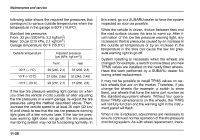2005 Subaru Legacy Owner's Manual - Page 548
2005 Subaru Legacy Manual
Page 548 highlights
Maintenance and service Tires and wheels ! Types of tires You should be familiar with type of tires present on your vehicle. ! All season tires The factory-installed tires on your new vehicle are all season tires. All season tires are designed to provide an adequate measure of traction, handling and braking performance in year-round driving including snowy and icy road conditions. However all season tires do not offer as much traction performance as winter (snow) tires in heavy or loose snow or on icy roads. All season tires are identified by "ALL SEASON" and/ or "M+S" (Mud & Snow) on the tire sidewall. ! Summer tires Summer tires are high-speed capability tires best suited for highway driving under dry conditions. Summer tires are inadequate for driving on slippery roads such as on snow-covered or icy roads. If you drive your vehicle on snow-covered or icy roads, we strongly recommend the use of winter (snow) tires. When installing winter tires, be sure to replace all four tires. ! Winter (snow) tires Winter tires are best suited for driving on snow-covered and icy roads. However winter tires do not perform as well as summer tires and all season tires on roads other than snow-covered and icy roads. ! Tire pressure monitoring system (TPMS) (if equipped) The tire pressure monitoring system provides the driver with a warning message indicating by sending a signal from a sensor that is installed in each wheel when tire pressure is severely low. The tire pressure monitoring system will activate only when the vehicle is driven. Also, this system may not react immediately to a sudden drop in tire pressure (for example, a blowout caused by running over a sharp object). If you adjust the tire pressures in a warm garage and will then drive the vehicle in cold outside air, the resulting drop in tire pressures may cause the low tire pressure warning light to come on. To avoid this problem when adjusting the tire pressures in a warm garage, inflate the tires to pressures higher than those shown on the tire placard. Specifically, inflate them by an extra 1 psi (6.9 kPa, 0.07 kgf/cm2) for every difference of 10°F (5.6°C) between the temperature in the garage and the temperature outside. By way of example, the - CONTINUED - 11-49
















